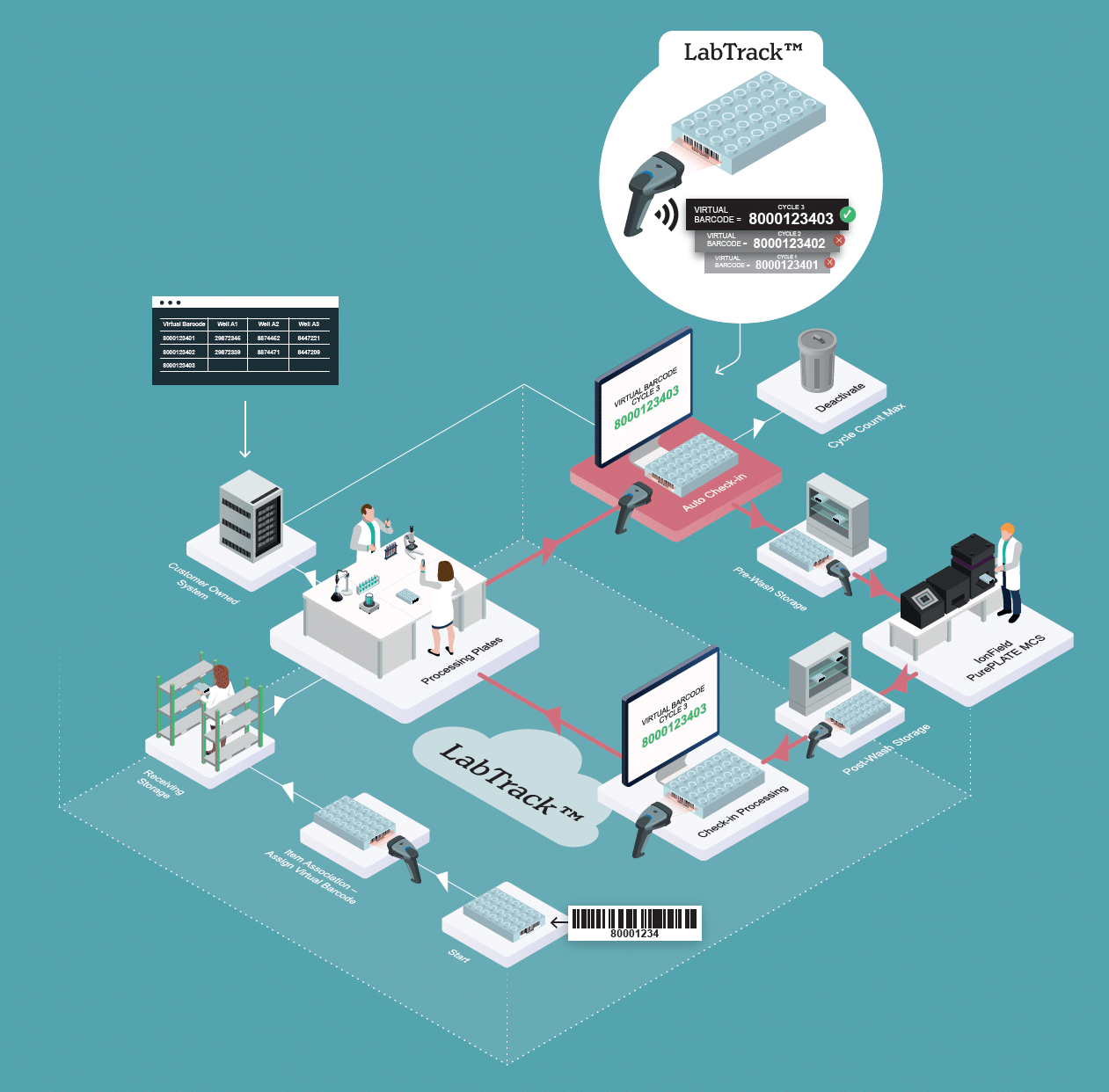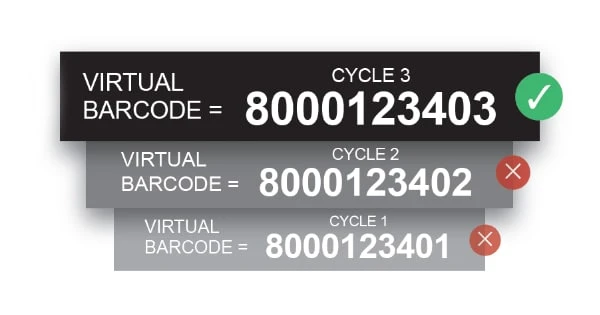Traditional microplate handling methods often result in single-use scenarios, leading to excessive waste and costs. However, new technologies such as virtual barcodes and advanced cleaning systems offer a solution for labs to enhance asset management. Let’s explore how integrating virtual barcodes, LabTrack™ management software, and innovative plate washing technology enables laboratories to wash and reuse microplates effectively while maintaining data integrity and traceability.
Part 1: Virtual Barcodes
At the heart of this solution is the advent of virtual barcodes, which transform the way laboratories track and manage microplates. It begins with the application of a permanent physical barcode to each microplate, ensuring durability and longevity in harsh laboratory environments. This physical barcode serves as the foundation upon which virtual barcodes are built, allowing for the seamless tracking of a single microplate throughout multiple lifecycles.
Once the physical plate is entered into LabTrack™, the software will generate a virtual barcode to represent the first cycle. For example, let’s say the physical barcode on the plate is identified by the sequence 80001234; the first virtual barcode could be 8000123401.
Virtual barcodes represent digital surrogates for their physical counterparts, providing laboratories with a flexible and versatile means of asset management. Scanning the physical barcode provides information on the physical asset including essential information such as usage history, location, and cycle status. This digitized approach not only streamlines asset management processes but also promotes sustainability by enabling the reuse of microplates.
Part 2: LabTrack™
LabTrack™ software plays a pivotal role in the management of virtual barcodes and microplate assets, serving as the centralized hub for laboratory asset management. It provides laboratories with real-time visibility into asset activity and usage history, ensuring comprehensive oversight of microplate lifecycles.
One of the hallmark features of LabTrack™ is its robust cycle management capabilities, which meticulously track each cycle, from initial use to subsequent cleaning and reuse. LabTrack™ manages virtual barcode cycles with meticulous attention to detail, ensuring that microplates are reused in accordance with predefined parameters and usage limits. Laboratories have the flexibility to set maximum cycle counts for each microplate type, allowing LabTrack™ to monitor usage and generate new virtual barcodes as needed.
When a microplate reaches the end of its current cycle, LabTrack™ seamlessly generates a new virtual barcode sequence, ensuring a clear audit trail and preventing duplicate identifiers. This automated process minimizes manual intervention and reduces the risk of errors, enabling laboratories to maintain accurate records of microplate usage and history.
Moreover, LabTrack™ goes beyond cycle management by seamlessly integrating with laboratory information management systems (LIMS), providing laboratories with a unified platform for data management and analysis.
Through this integration, LabTrack™ facilitates the seamless exchange of information between virtual barcode management and internal software systems.
By leveraging LabTrack™’s integration capabilities, laboratories can streamline data recording and analysis processes, enhancing productivity and efficiency.
When laboratory personnel log experimental data in their LIMS, LabTrack™ ensures that the virtual barcode serves as the unique identifier for each sample, maintaining consistency and accuracy in data management.
Part 3: PurePLATE™ Microplate Cleaning System
IonField’s PurePLATE™ Microplate Cleaning System represents a significant paradigm shift in the reuse of microplates. Microplates do not degrade through use in typical assay processes, such as containers for compounds in drug screening, running cell assays, PCR sample preparation, etc. Traditionally, they have not been reused because ensuring adequate cleanliness for any subsequent application has been challenging.
IonField’s MCS innovates with an aggressive rinse process followed by exposure to a high-energy, non-thermal plasma generated from room air. The plasma contains ozone, hydroxide, energetic nitrogen compounds, singlet oxygen, and other reactive gases that oxidize organic molecules on contact. The system is engineered to cater to a broad spectrum of microplate formats – any microplate with an SBS-standard base up to 44 mm in thickness, in any hole format, that is solid polymer or a composite polymer upper well structure with a specialized bottom (made from a polymer, ceramic, glass, or glass with diffraction gratings), or semi-skirted SBS base microplates.
PurePLATE™ features cutting-edge cleaning technology that ensures the complete destruction of potential contaminants. Microplates, often used in delicate assays and complex experimental protocols, can harbor residues from previous samples that could skew results and invalidate research. When there is an established standard for cleanliness, such as ‘PCR Clean’, PurePLATE™ meets that benchmark.
By integrating PurePLATE™ into their workflows, research facilities can dramatically reduce their plastic waste, save significantly on the costs of microplates by reusing them, and contribute to a more sustainable research model.

Integration and Synergy: A Sustainable Solution
Together, virtual barcodes, LabTrack™ software, and the PurePLATE™ Microplate Cleaning System form a complete and integrated solution for laboratory sustainability. The digitization of microplate management through virtual barcodes, coupled with the robust asset tracking capabilities of LabTrack™, enables laboratories to optimize resource utilization and minimize waste. The addition of the PurePLATE™ system ensures that microplates are cleaned and reused with confidence, further enhancing sustainability efforts.
In conclusion, the integration of virtual barcodes, LabTrack™ software, and the PurePLATE™ Microplate Cleaning System represents a paradigm shift in laboratory sustainability. By digitizing asset management, streamlining processes, and enabling reuse with confidence, this comprehensive solution empowers laboratories to embrace sustainable practices while driving scientific innovation forward. As laboratories continue to adopt these technologies, they embark on a journey towards a greener, more sustainable future for scientific research and development.

